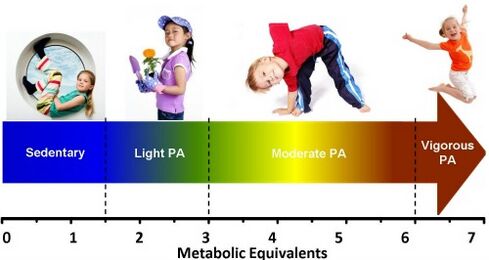Sedentary Behaviour
Original Editor - Lucinda hampton
Top Contributors - Lucinda hampton, Uchechukwu Chukwuemeka and Shaimaa Eldib
Introduction[edit | edit source]
Sedentary behaviour refers to “any waking behavior characterized by an energy expenditure ≤1.5 metabolic equivalents (METs), while in a sitting, reclining or lying posture”. Many adults spend roughly 9–10 h/day engaging in sedentary behaviours. Given this level of exposure, an understanding of its relationship with health outcomes is vital for the general public.[1]
Risky Behaviour[edit | edit source]
A sedentary lifestyle is a risky behaviour. It has many adverse health effects, for example elevated all-cause mortality, CVD mortality, cancer risk, risks for metabolic diseases such as diabetes, hypertension, dyslipidemia, musculoskeletal diseases (eg knee pain and osteoporosis) and mental health problems. The negative health impacts escalate with increases in the total daily sedentary times. For this reason, it is important to reduce the sedentary time as much as possible.[2]
Sedentary Behaviour vs Physical Inactivity[edit | edit source]
Sedentary behaviours are considered conceptually distinct from physical inactivity, with the latter referring to performing insufficient amounts of moderate-to-vigorous physical activity (MVPA) to meet current physical activity recommendations.[3]
WHO Guidelines[edit | edit source]
The WHO 2020 guidelines on physical activity and sedentary behaviour give new advice on sedentary behaviour and its interrelationships with physical activity, providing a broader, mutually reinforcing set of behavioural targets to help improve population health,aiming to limit sedentary behaviour and increase physical activity among those who need it most. These new sedentary behaviour guidelines should elicit more targeted research in this area and be a stimulus for more system-wide policies, programs, and initiatives to help improve global health.[3]
Physiotherapy[edit | edit source]
Physical activity is essential for a healthy life and spending the majority of the day being sedentary is dangerous.
Physiotherapists can advise people to reduce the amount of time they spend being sedentary suggesting ways to change sedentary habits, for example:
- Stand on public transport
- Walk/walk part way to work
- Walk during lunch breaks and/or breaks
- Stand up every 30 minutes when working at a desk
- Use a standing desk or ask the workplace to provide one
- Increase the manual chores done around the house
- Walk around when taking phone calls
- Join community/friend activity groups in free time rather than watching television or playing video games
- Get a dog and walk regularly
- Take the stairs instead of using the elevator
- numbered list
- x
References[edit | edit source]
- ↑ Saunders TJ, McIsaac T, Douillette K, Gaulton N, Hunter S, Rhodes RE, Prince SA, Carson V, Chaput JP, Chastin S, Giangregorio L. Sedentary behaviour and health in adults: an overview of systematic reviews. Applied Physiology, Nutrition, and Metabolism. 2020;45(10):S197-217.Available:https://cdnsciencepub.com/doi/full/10.1139/apnm-2020-0272?rfr_dat=cr_pub++0pubmed&url_ver=Z39.88-2003&rfr_id=ori%3Arid%3Acrossref.org (accessed 10.10.2022)
- ↑ Park JH, Moon JH, Kim HJ, Kong MH, Oh YH. Sedentary lifestyle: overview of updated evidence of potential health risks. Korean journal of family medicine. 2020 Nov;41(6):365. Available: https://www.ncbi.nlm.nih.gov/pmc/articles/PMC7700832/(accessed 10.10.2022)
- ↑ 3.0 3.1 Dempsey PC, Biddle SJ, Buman MP, Chastin S, Ekelund U, Friedenreich CM, Katzmarzyk PT, Leitzmann MF, Stamatakis E, van der Ploeg HP, Willumsen J. New global guidelines on sedentary behaviour and health for adults: broadening the behavioural targets. International Journal of Behavioral Nutrition and Physical Activity. 2020 Dec;17(1):1-2.Available:https://ijbnpa.biomedcentral.com/articles/10.1186/s12966-020-01044-0 (accessed 10.10.2022)








